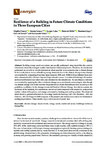Resilience of a Building to Future Climate Conditions in Three European Cities
| dc.contributor.author | Ciancio, V | |
| dc.contributor.author | Falasca, S | |
| dc.contributor.author | Golasi, I | |
| dc.contributor.author | de Wilde, Pieter | |
| dc.contributor.author | Coppi, M | |
| dc.contributor.author | de Santoli, L | |
| dc.contributor.author | Salata, F | |
| dc.date.accessioned | 2021-10-15T13:01:05Z | |
| dc.date.available | 2021-10-15T13:01:05Z | |
| dc.date.issued | 2019-11-27 | |
| dc.identifier.issn | 1996-1073 | |
| dc.identifier.issn | 1996-1073 | |
| dc.identifier.other | ARTN 4506 | |
| dc.identifier.uri | http://hdl.handle.net/10026.1/18078 | |
| dc.description.abstract |
Building energy need simulations are usually performed using input files that contain information about the averaged weather data based on historical patterns. Therefore, the simulations performed are not able to provide information about possible future scenarios due to climate change. In this work, future trends of building energy demands due to the climate change across Europe were studied by comparing three time steps (present, 2050, and -2080) in three different European cities, characterized by different Köppen-Geiger climatic classes. A residential building with modern architectural features was taken into consideration for the simulations. Future climate conditions were reached by applying the effects of climate changes to current hourly meteorological data though the climate change tool world weather file generator (CCWorldWeatherGen) tool, according to the guidelines established by the Intergovernmental Panel on Climate Change. In order to examine the resilience of the building, the simulations carried out were compared with respect to: peak power, median values of the power, and energy consumed by heating and cooling system. The observed trend shows a general reduction in the energy needs for heating (–46% for Aberdeen, –80% for Palermo, –36% for Prague in 2080 compared to the present) and increase (occurrence for Aberdeen) in cooling requirements. These results imply a revaluation of system size. | |
| dc.format.extent | 4506-4506 | |
| dc.language | en | |
| dc.language.iso | en | |
| dc.publisher | MDPI | |
| dc.subject | climate change | |
| dc.subject | future trends | |
| dc.subject | energy needs | |
| dc.subject | residential sector | |
| dc.subject | buildings resilience | |
| dc.subject | EnergyPlus | |
| dc.title | Resilience of a Building to Future Climate Conditions in Three European Cities | |
| dc.type | journal-article | |
| dc.type | Journal Article | |
| plymouth.author-url | https://www.webofscience.com/api/gateway?GWVersion=2&SrcApp=PARTNER_APP&SrcAuth=LinksAMR&KeyUT=WOS:000514090100104&DestLinkType=FullRecord&DestApp=ALL_WOS&UsrCustomerID=11bb513d99f797142bcfeffcc58ea008 | |
| plymouth.issue | 23 | |
| plymouth.volume | 12 | |
| plymouth.publication-status | Published online | |
| plymouth.journal | Energies | |
| dc.identifier.doi | 10.3390/en12234506 | |
| plymouth.organisational-group | /Plymouth | |
| plymouth.organisational-group | /Plymouth/Faculty of Arts, Humanities and Business | |
| plymouth.organisational-group | /Plymouth/REF 2021 Researchers by UoA | |
| plymouth.organisational-group | /Plymouth/REF 2021 Researchers by UoA/UoA13 Architecture, Built Environment and Planning | |
| dcterms.dateAccepted | 2019-11-26 | |
| dc.rights.embargodate | 2021-10-16 | |
| dc.identifier.eissn | 1996-1073 | |
| dc.rights.embargoperiod | Not known | |
| rioxxterms.versionofrecord | 10.3390/en12234506 | |
| rioxxterms.licenseref.uri | http://www.rioxx.net/licenses/all-rights-reserved | |
| rioxxterms.licenseref.startdate | 2019-11-27 | |
| rioxxterms.type | Journal Article/Review |


